Boot: 2023-2024 Atomic Backland XTD Carbon 120
Stated Flex: 120
Available Sizes: 24.0–30.5
Stated Last (size 26.5): 100 mm
Stated Range of Motion: 74°
Stated Forward Lean: 15° (adjustable to 13° and 17°)
Size Tested: 26.5
Stated Boot Sole Length (size 26.5): 297 mm
Blister’s Measured Weight (size 26.5):
- Shells, no Liners: L: 1084 & R: 1085 g
- Liners, no Footbeds: L: 290 g & R: 286 g
- Shells + Liners = 1374 & 1371 g
- Stock Insoles: 21 & 21 g
Buckles:
- 1 Upper (7000-series alluminum; micro-adjustable; w/ tour latch)
- 1 Lower (“Cross Lace 2.5” cable system)
Power Strap: 50 mm cam-style w/ quick release
Shell Material:
- Cuff: Carbon-Loaded Polyamide (PA)
- Lower Shell / Shoe: Carbon-Loaded Polyamide (PA)
Soles: fixed full-rubber (ISO 9523)
Binding Compatibility: pin / tech bindings; MNC bindings
Tech Fittings: “Investment Cast Tech Inserts”
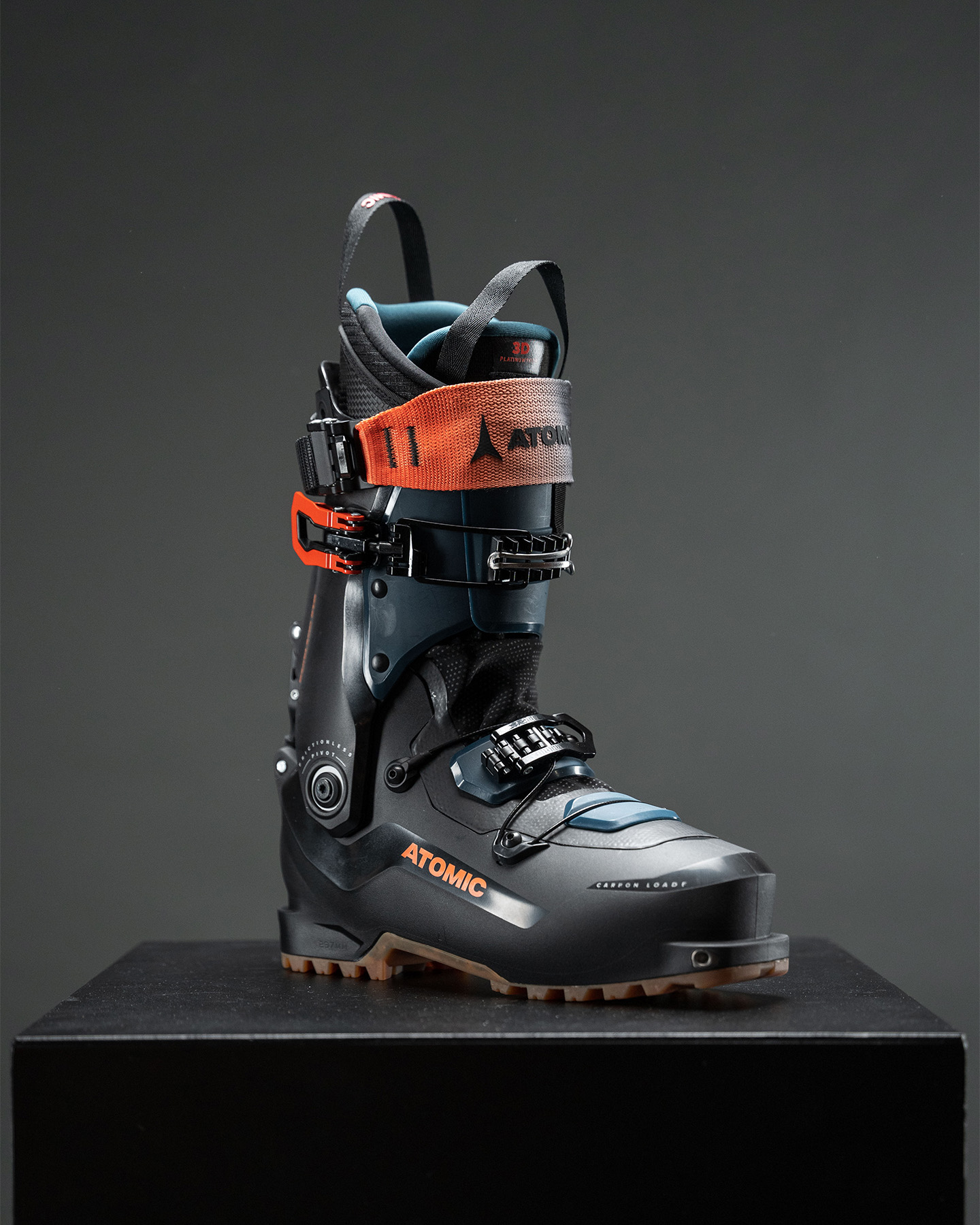
Intro
Atomic’s Backland lineup of boots has long served as their dedicated touring models, offering a lighter, more uphill-friendly platform than the brand’s stiffer, heavier Hawx XTD models.
In recent years, Atomic has expanded their Backland lineup to suit everyone from skimo racers to all-round ski tourers who don’t want / need alpine-boot performance in the backcountry.
Despite that expansion, all the Backland models were pretty uphill-oriented in the grand scheme, topping out at a stated 110 flex and typically falling below 1200 grams for a size 26.5 in the high-end models.
For the 2023-2024 season, Atomic is adding another series under the Backland umbrella, the Backland XTD. These are the most downhill-oriented boots that feature the Backland name, essentially filling the gap between the Backland and Hawx XTD series (see our writeup of the 23/24 Hawx Ultra XTD 130 BOA for more on those boots).
We’ve been spending time in the stiffest Backland XTD, the Backland XTD Carbon 120, and Blister Members can check out our initial on-snow impressions in our Flash Review. Furthermore, if you want to hear all about the backstory of these boots and everything else Atomic has going on for the 23/24 season, be sure to check out our GEAR:30 conversation with Atomic Ski Boot Product Manager, Matt Manser.
For now, let’s get into the details of the new Backland XTD series, and the Backland XTD Carbon 120 in particular.
The 2023-2024 Atomic Backland Boots
For the 23/24 season, there are several different boot collections that fall under the “Backland” name, but they vary a great deal. Here’s a brief rundown:
- Backland Ultimate (single model)
- Lightest, most minimal, most uphill-oriented boot; ~788 grams; 96 mm last; 80 flex
- Backland UL (Backland Carbon UL, Backland Pro UL, Backland Pro UL W)
- Slightly more versatile / more downhill-oriented alternative to Backland Ultimate; ~1050 g; 98 mm last; 95-110 flex
- Backland SL (Backland Pro SL & Backland Pro SL W)
- Mixes quick transition setup of Backland UL with slightly burlier build; ~1100 g; 98 mm last; 95-100 flex
- Backland (Backland Carbon, Backland Pro, Backland Expert, Backland Sport, Backland Pro W, Backland Expert W)
- Separate power strap & upper buckle not linked to walk mechanism; ~1050-1200 g; 98 mm last; 85-110 flex
- Backland XTD (Backland XTD Carbon 120, Backland XTD Carbon 120 GW, Backland XTD 110, Backland XTD 100 GW, Backland XTD Carbon 115 W, Backland XTD 105 W, Backland XTD 95 W, Backland XTD 85 W)
- Most downhill-oriented of the Backlands; ~1380-1520 g; 100 mm last; 85-120 flex
Now that we have a full overview of the entire Backland lineup, let’s focus on the Backland XTD, in particular:
What Atomic says about the Backland XTD Series
“Built for those ski tourers looking for a medium-fit boot that offers rock-solid handling on the down and can climb anything on the way up, the all-round Backland XTD is your ticket to a season of touring adventures.”
A note on sizing: for the 23/24 season, the men’s Backland XTD boots are available from size 24 to size 30.5; women’s models are available from size 22 to size 27.5
Shell
Depending on the model, the Backland XTD boots feature Carbon-Loaded Polyamide (PA), True Flex Polyurethane (PU), standard PU, and/or standard PA for the cuffs and lower shells.
The Backland XTD Carbon 120, Backland XTD Carbon 120 GW, and Backland XTD Carbon 115 W all feature top-of-the-line Carbon-Loaded PA for both their upper cuffs and lower shells.
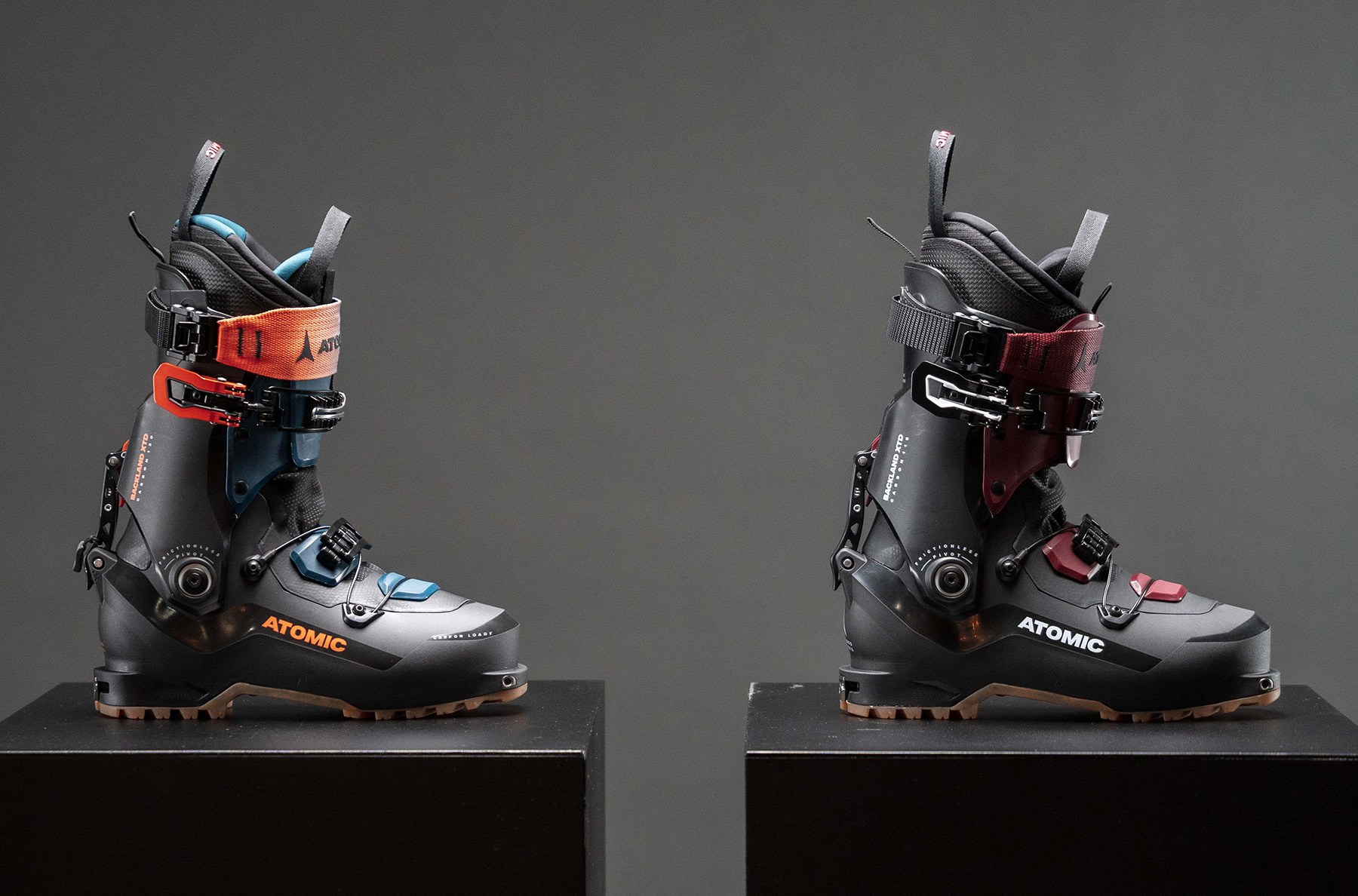
Atomic calls the shell layout a “Hybrid Overlap” design, which seems fair. The two parts of the cuff overlap at the top, while the lower shell features an opening over the top that’s covered by a textile gaiter and two partial plastic pieces under the cables and buckle that make up the lower closure. I.e., it’s not a full overlap like the Hawx XTD boots and its cuff overlap is smaller to create more range of motion, but it features a bit more plastic reinforcement than the other Backland boots.
Liner
All of the Backland XTD boots feature fairly light, minimal liners, but they’re a bit more substantial than the other Backland boots’ liners. The Backland XTD Carbon 120 features the highest-end liner, dubbed “3D Platinum Tour,” which is heat moldable. It’s quite light and flexible overall, but is more substantial (especially at the cuff and ankle) than most boots’ liners in the <1200-g class.
Walk Mechanism
The “Free/Lock 4.5” walk mechanism on the Backland XTD boots is very familiar, since it’s extremely similar to the walk mechanisms that Atomic has put on nearly all their touring boots. It’s fully external and consists of a big lever on the upper cuff that connects to a bar on the lower shell when in ski mode. It’s easy to use with gloves and we’ve previously had great experiences with it on other boots.
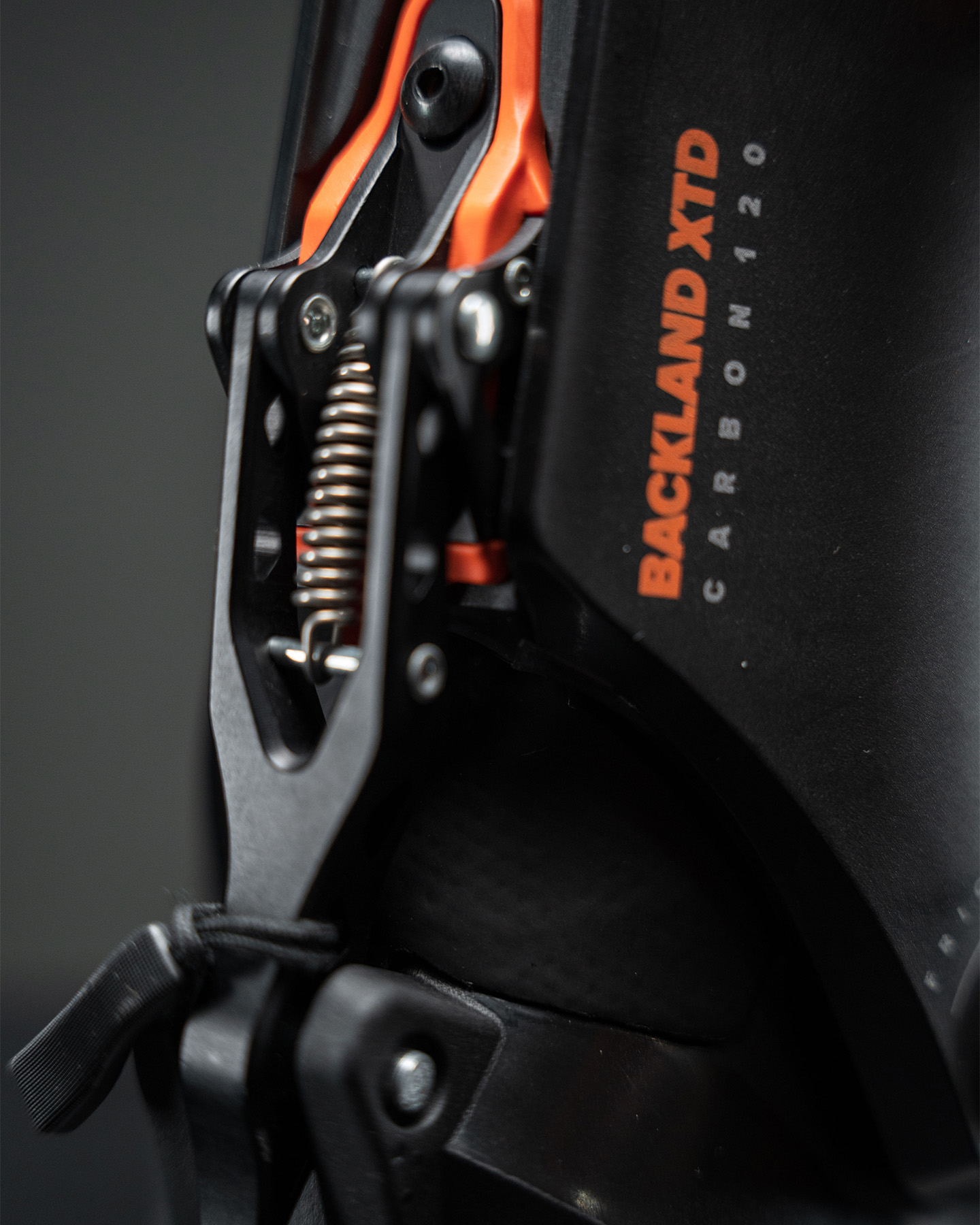

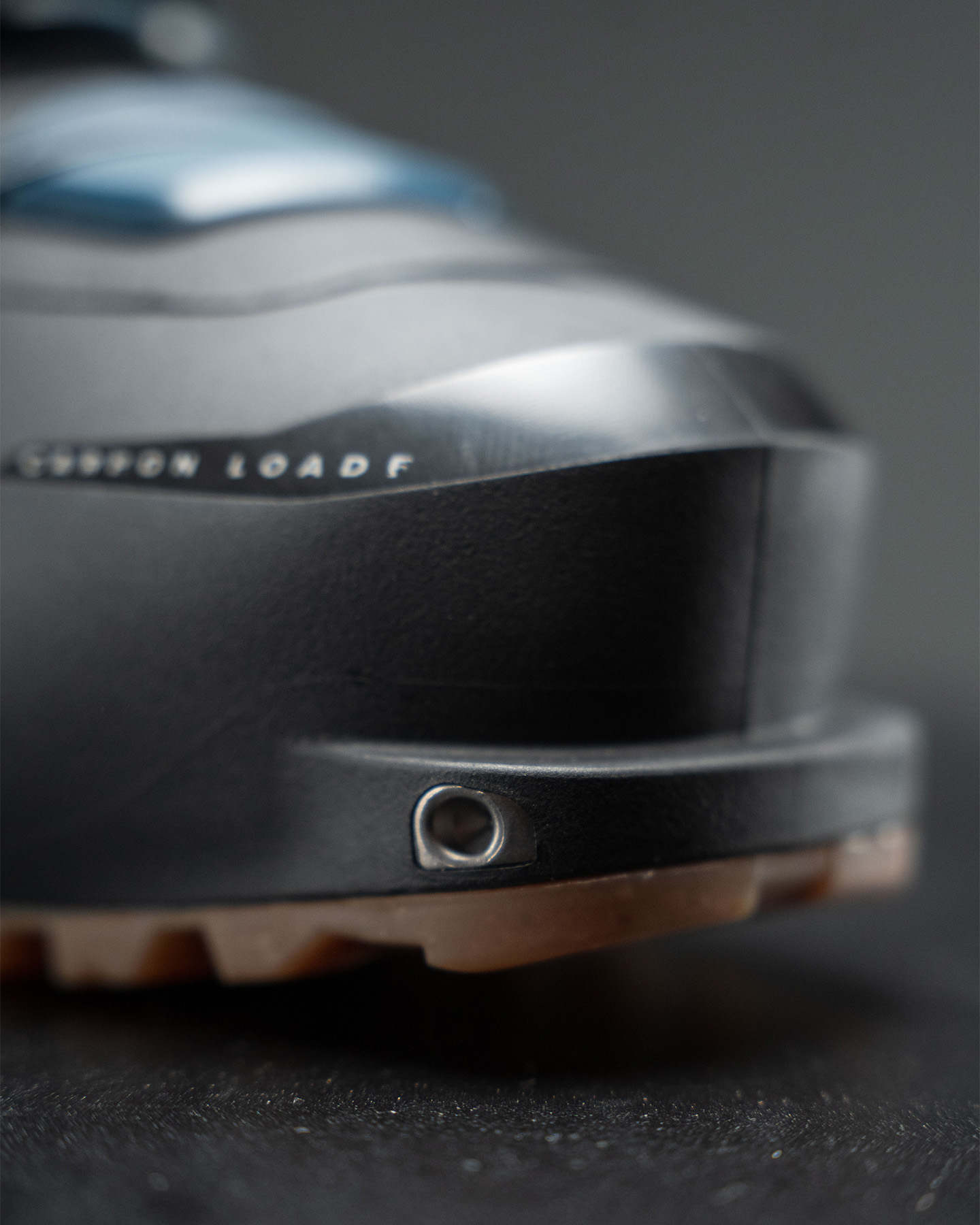

Adjustable Forward Lean
On that note about the Free/Lock walk mechanism, it has built-in forward lean adjustment. The Backland XTD comes stock with 15° of forward lean, but can be adjusted to 13° or 17° by sliding a chip where the walk mechanism attaches to the upper cuff.
Buckles
The Backland XTD boots feature two buckles: one pretty standard one on the upper cuff, and one above the instep that tightens a cable that runs from the forefoot to the ankle. This is a pretty similar layout to the regular Backland series, though the Backland XTD features more substantial plastic reinforcements under its lower cables.
Power Strap
The top-of-the-line Backland XTD Carbon 120 and Backland XTD Carbon 115 W feature a 50 mm and 40 mm power strap, respectively, that’s tightened and loosened by a really nice cam-style buckle with a quick-release mechanism. The strap itself is a very thin but sturdy-feeling fabric.
The other models feature more typical velcro-style power straps of varying widths.
Soles
Unlike the other Backland boots, the Backland XTD boots feature an ISO 9523 touring sole that can work with MNC bindings (the Backland XTD boots with “GW” in their name have GripWalk soles that also work with GripWalk / ISO 23223 bindings).
The non-GW Backland XTD boots’ soles are still full-length rubber and non replaceable, with Atomic’s “Skywalk” tread and rubber compound.
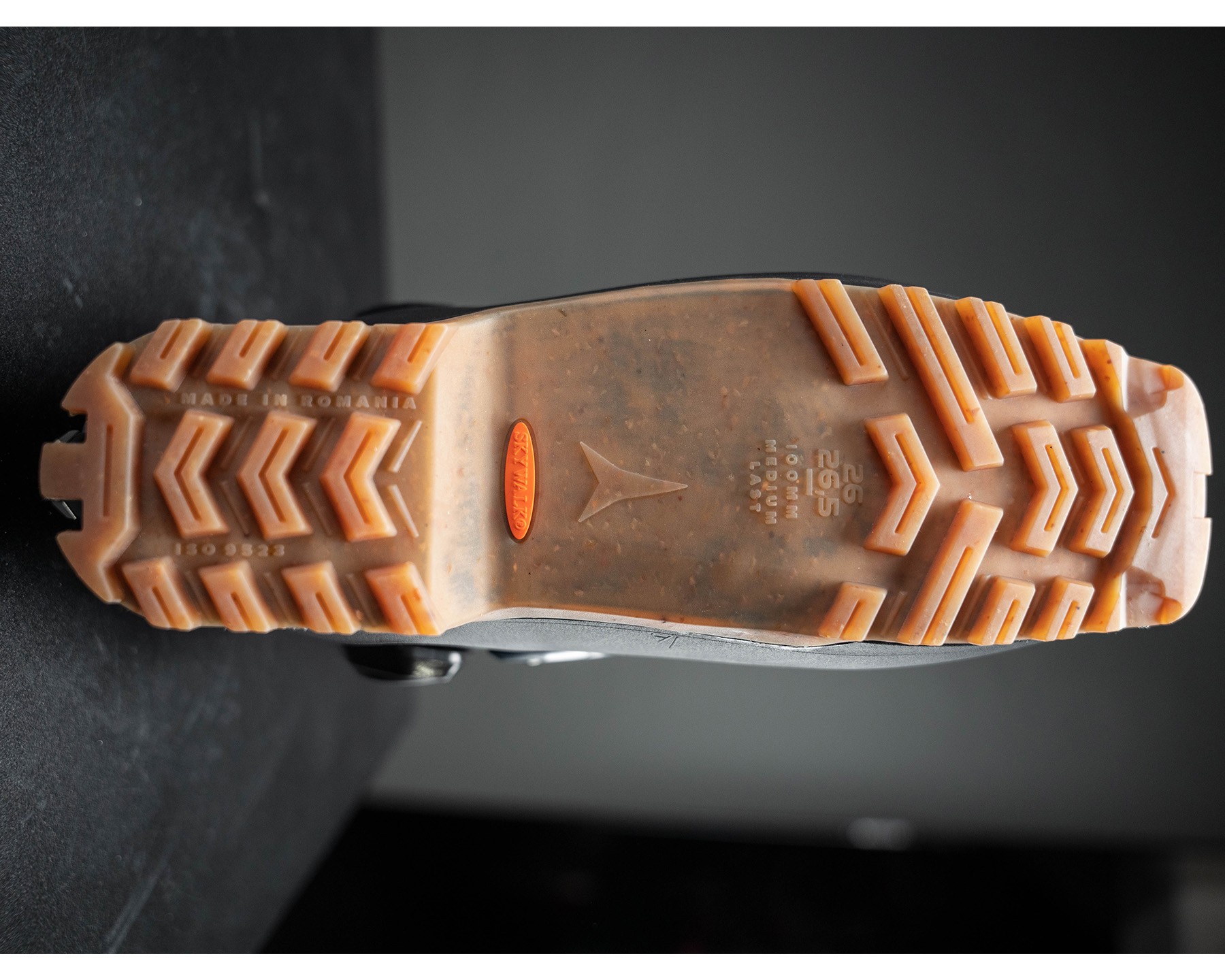
And of course, all the Backland XTD boots feature tech inserts for use with tech / pin “TLT” bindings.
Weight & Comparisons
Our size 26.5 Backland XTD Carbon 120 weighs about 1370 grams per boot. That’s notably lighter than most 130-flex “freeride touring” boots like the Atomic Hawx Ultra XTD, Scarpa Maestrale, and Dynafit Hoji Free, but also a fair bit heavier than what we often call “lightweight touring” boots like the Atomic Backland Carbon and Salomon S/Lab MTN Summit.
However, there seems to be a new subcategory forming between those two classes (apparently we’re gonna need to come up with yet another category name…). The most notable example is the Fischer TransAlp Pro, which comes in at a very similar weight and stated specs. The Salomon S/Lab MTN Summit is also similar in terms of stated flex and downhill performance, though it’s notably lighter.
Below is a number of our measured weights of other boots with walk mechanisms. We list the weights of each shell + the weights of each liner, then the total weights of the shells + liners. You can click on the link for each boot to see which model year(s) the weights apply to.
Tecnica Zero G Peak Carbon (27.5): 844 & 854 + 231 & 227 = 1075 & 1081 g
Scarpa F1 LT (28.0 / 27.5): 1106 & 1101 g
Atomic Backland Carbon (27.5): 882 & 884 + 228 & 230 = 1110 & 1114 g
Salomon S/Lab MTN Summit (26.5): 963 g & 971.5 + 212.5 & 215 = 1187 & 1178 g
Salomon S/Lab X-Alp (28.0): 1010 & 1010 + 222 & 222 = 1232 7 1232 g
Tecnica Zero G Tour Pro (26.5): 1099 & 1100 + 210 & 211 = 1309 & 1311 g
Fischer Transalp Pro (26.5): 1053 & 1053 + 262 & 263 = 1315 & 1316 g
Atomic Backland XTD Carbon 120: 1084 & 1085 + 290 & 286 = 1374 & 1371 g
Dynafit Hoji Pro Tour (26.5): 1169 & 1174 + 214 & 215 = 1383 & 1389 g
Scarpa 4-Quattro XT (26.5 / 27.0): 1248 & 1246 + 228.5 & 229 = 1476.5 & 1475 g
Scarpa Maestrale XT (26.5 / 27.0): 1258 & 1258 + 247 & 252 = 1505 & 1510 g
Atomic Hawx Ultra XTD 130 (26.5): 1147 & 1150 + 403 & 404 = 1550 & 1554 g
Roxa R3 130 T.I. (27.5): 1319 & 1320 + 263 & 263 = 1582 & 1583 g
Head Kore RS 130 GW (26.5): 1334 & 1340 + 279 & 276 = 1613 & 1616 g
Dynafit Hoji Free (27.5): 1317 & 1332 + 331 & 325 = 1648 & 1657 g
Atomic Hawx Prime XTD 130 (26.5): 1242 & 1249 + 408 & 410 = 1650 & 1659 g
K2 Mindbender 130 (26.5): 1428 & 1427 + 346 & 348 = 1774 & 1775 g
Fischer Ranger Pro 130 GW DYN (26.5): 1381 & 1381 + 388.5 g & 392.5 = 1770 & 1774 g
Lange XT3 130 LV (26.5): 1407 & 1410 + 368 & 368 = 1775 & 1778 g
Atomic Hawx Ultra XTD 130 BOA GW (26.5): 1385 & 1386 + 406 & 405 = 1791 & 1791 g
Nordica Strider Pro 130 DYN (27.5): 1445 & 1440 + 363 & 373 = 1808 & 1813 g
Tecnica Cochise 130 (22/23) (26.5): 1398 & 1405 + 422 & 419 = 1820 & 1824 g
Dalbello Lupo Pro HD w/o Tongues (26.5): 1589 & 1596 + 266 & 267 = 1855 & 1863 g
Full Tilt Ascendant SC w/o Tongues (26.5): 1577 & 1576 + 286 & 288 = 1863 & 1864 g
Head Kore 120 GW (27.5): 1472 & 1477 + 477 & 477.5 = 1949 & 1954.5 g
Dalbello Lupo Pro HD w/ Tongues (26.5): 1747 & 1754 + 266 & 267 = 2013 & 2021 g
Full Tilt Ascendant SC w/ Tongues: 1740 & 1739 + 286 & 288 = 2026 & 2027 g
Fit
As always, our “Fit” sections will never replace the usefulness of the advice of an experienced bootfitter, nor are they designed to do so. The fit of any boot is the deciding factor and everyone’s feet are different, so we highly, highly recommend visiting a bootfitter before settling on a boot. With that said, here are some of my thoughts on how the Backland XTD fits my feet. For reference, I have a fairly wide midfoot (a little over 100 mm when unsupported), low instep, low-volume ankle, and skinny calves. The Tecnica Mach1 MV and Nordica Strider are the boots with which I’ve gotten the best out-of-the-box fit.
As the only 100mm-lasted boot under the Backland name, the Backland XTD boots feature a higher-volume fit overall. Despite not looking all that wide, I haven’t yet experienced any midfoot pain in them, which is extremely rare for me (all I’ve done to adjust fit is put in my custom insoles).
The ankle pocket feels fairly snug, relative to the midfoot volume, while the toe box maybe feels a touch lower volume than average for a 100mm-last boot. I think the instep fit should be versatile, given that the plastic doesn’t fully extend over that area. I was able to crank the lower buckle down enough to get a secure fit over my low instep, though it does create a bit of a pressure point where the buckle is. Overall, this is one of the most comfortable out-of-the-box fits I’ve experienced for my (pretty tricky) feet. We’ll see how / if that changes over time.
Bottom Line (For Now)
The “touring boot” category continues to diversify, and just when we thought we had a handle on the various subcategories under that umbrella, Atomic has shaken things up with their new Backland XTD boots. Blending the simple buckle layout and (fairly) low weight of more uphill-oriented boots with some of the downhill-oriented features and flex patterns of heavier models, the Backland XTD boots look like they could make for versatile touring options for those caught between the established categories.
Blister Members can check out our initial on-snow impressions in our Flash Review linked below, and then we’ll chime back in with a full review once we’ve been able to spend much more time in these boots.
Flash Review
Blister Members can read our Flash Review of the Backland XTD Carbon 120 for our initial on-snow impressions. Become a Blister member now to check out this and all of our Flash Reviews, plus get exclusive deals and discounts (including 10-20% off skis from 10+ brands), and personalized gear recommendations from us.


My biggest gripe with the Fischer Transalp Pro and now these, is that they go and ruin what could be a really good long trip boot for people who like to ski, by putting full toe lugs on them so they can be used in downhill binders – this makes them average to walk in vs. toe lugs that are only designed to accept a crampon bail…
Hi Tom, fair point – a non-norm sole would be lighter and walk more naturally. But the big reason for an ISO 9523 sole is binding compatibility, not just for alpine bindings but for hybrid bindings like the Shift, Kingpin and Tecton. You can’t use those bindings with a non-norm sole.
So what Tom wants to know: how much plastic can one grind off the front off the toe before the tech insert becomes insecure? ;-)
I have a Scarpa F1 from 2018/2019 that has a non-norm toe but works OK in a Tecton binding
This boot comes damn close to the original 19/20 Hawx Ultra 130 XTD in terms of weight. A direct comparison regarding touring and downhill performance would be great!
Are these filling the region that the previous model Hawx XTD 130 covered? Since the new model got quite a bit heavier and more 50/50 oriented I was hoping they’d cover the gap and this seems to be it.
Hi Karl – think of it this way: Hawx XTD boots are alpine boots that can go touring and the Backland XTD boots are touring boots that ski really well. You can use our Hawx XTD boots in the resort, all day long but I wouldn’t do the same with a Backland XTD. The Hawx XTD boots will ski circles around the Backland XTD, but the Backland XTD will leave the Hawx XTD far behind on the skin track. It just depends on which compromise is more important to you. And remember- compromises aren’t a bad thing, just part of the reality we live in and an honest discussion about them will help make gear choices clearer and easier. -Matt
Today I have Hawk XTD (old model 2021-22) that I use for all types of skiing. I’m thinking maybe replace them with Backland XTD but it might be better to complement the Hawk with Backland Carbon? The Backland XTD is probably not that good in piste? But it is also nice to only have one pair of boots.
Hard to imagine just by basic construction knowledge that something with less overlap and material will perform as high as something with actual full overlap.
I think it makes sense for boots in the beefy touring category to be compatible with beefy touring bindings. I know lots of people want a binding like Tecton, Shift, Duke or at least Kingpins.
I am not one of them, but look around at trailheads or the Internet, and people who worry about skiing performance and don’t mind a bit of weight(ie the same customers who would buy this boot or the Transalp), are often picking those bindings.
The other group is people like my wife: her Alpine skis are not too heavy, and have Shifts on them. If we are doing a trip with only a day or so of touring, she might bring just her touring boots, along with her alpine boots and skis.
The one place where I do agree with your question, is that this boot, unlike any other AT I know of, comes in two sole versions: AT and GW.
So, if it was up to me, I’d have made a GW version, for those who want max binding compatibility, and a short, non norm, rubber sole version.
But, Matt knows all this too, and being a professional, I am sure he has looked at market research to see what would sell best, which isn’t always what’s best for you and me, or even objectively the best for most people.
Let’s not forget about crampons… Personally I would never even consider a “speed nose” boot as it severely limits the terrain I can access safely.
Is the boot mouldable with the Memory Fit process? Didn’t notice any mention about that.
Hi Joel – sorry, we just have too much to talk about and not enough time to do it in haha. Yes, the shell is heat moldable either through traditional stretching or Memory Fit, depending on how many areas of adjustment you need. If you don’t need any of that, the liner is 100% heat moldable to help make a good fit even better. – Matt
“Free Mountaineering” it’s what happens when a company that knows how to make a WC Ski boot messes around with walk modes and lightweight shells. Unlike these “leather boot” companies trying to make a plastic walking boot, that skis.
Hi everyone,
this boot looks really interesting to me and I will be excited to try it on. I definitely like the fact that it has a full ISO 9523 sole. I have a Shift binding on my touring skis, like this binding for a lot of reasons and would be very hesitant to change to something with less consistent retention and release characteristics (meaning all other pin bindings). But I wouldn’t mind my boots walking more effortlessly with more forward ROM, so I certainly see an application for this boot.
It’s also great to see that this boot has what looks like a proper instep buckle and the non-overlap shell design in combination with that buckle should permit adjustment to a wider range of foot instep heights. And Luke is the first reviewer that I am aware of to point out the value that lies in this adjustability, rather than just classifying boots as low or high volume, as is often the case elsewhere, thank you!
In my case, an adaptability for a very low instep would be great. This is also my gripe with the Hawx Ultra XTD boot, which is my touring boot and that has a bit too high of an instep for me.
I have a couple of fit questions on this boot.
– I love the narrow and relatively deep heel pocket of the Hawx Ultra, is this similar on the Backland XTD? On previous Backlands it seemed to be wider.
– the Hawx Ultra stance angles are the best for my anatomy and skiing style that I’ve come across, so are the boot board ramp angles comparable when in a Shift binding? Of course, a heel wedge can permit some adjustment, but raising the heel also lifts the foot upwards out of the heel pocket, so it’s always preferable to have the manufacturer design it in.
– it looks as though the last is not as low down in the boot as with the Hawx, where the toes of the feet sit somewhere behind the toe lugs. This is great for the low stand-over height in the Hawx, but it makes punching or molding the boots for big toe length impossible at home and for my bootfitter. Here it seems the foot might be placed more above the upper end of the toe binding lug, is this correct? Can they thus more easily be stretched for extra legth if required? This is my usual issue which prevents downsizing for ankle fit.
Cheers
Partly answer on the first question by Matt in the Year of the Boa Gear:30 podcast, the Backland XTD is built around a Hawx Prime last. So presumably, the heel pocket is wider than with the Hawx Ultra.
Hi Philipp – that’s correct, this is based on a Prime last, so a medium volume fit.
Stoked on the new design. Love my current Backland Carbon. They ski incredible for their weight and the freedom of movement on the climb is awesome. First pair of “uphill boots. That said, the Boa system has been a hassle. Slips, and needs replacing, falls off occasionally so i have become an amateur expert. Ready to never look at a boa again! And have some features like binding compatibility and a buckle on the front. What to do with used boots that have a broken boa but are otherwise good?
Hi Nate, you can get the BOA repaired and sell it once it is fixed. The current (22/23) Backland Carbon now comes with our Cross Lace, very similar to what is pictured here on the Backland XTD. The Cross Lace system generates more closing force than the M-series BOA system but still offers a clean lateral side vs. other buckle-operated closure systems. – Matt
As someone who used and still uses the original 17/18 Atomic Hawx Ultra XTD 130 exclusively for touring, how would you describe the differences or similarities in terms of fit, stiffness and flex between the new Backland XTD and the original Hawx Ultra XTD.
ever since my original liner started to deteriorate, I have been looking for a boot to replace my Hawx. something that would be a bit lighter, better for touring, with a proper rubber sole and better for transitions aka less annoying on the buckle-side. All this with still delivering a similar comfortable fit for my feet as well as flex.
Looks like the Backland XTD could be a contender. just worried now that its built on the prime last, so therefore I guess bigger volume compared to the Hawx Ultra XTD? I recently shop-tried the Fischer Transalp Pro which was the first getting somewhat close to what I’m looking for. Intriguing now that Luke seems to see some parallels between these two boots. Do I need to wait for next winter season to give the Backland XTD a serious look or do I just go with the Fischers now..?
Also a question on the new BOA technology: why didn’t they put it on the Backland XTD?
cheers
Hi derfredl – the new Backland XTD will be lighter and tour far better than your current Hawx Ultra XTD, but it will be a wider fit. Honestly, it’s more similar in purpose/fit to the Transalp you tried than your current boot. But, I honestly think you’ll find the fit, flex & cuff ROM to be better than the Transalp too.
Re: BOA – the new BOA system on the Hawx Ultra XTD is purpose built for heavier, thicker alpine boots with a traditional, overlap shell. On a true touring boot (like the Backland XTD) there just isn’t the space for the new BOA and it’s quite heavy, too. So for the Backland XTD it made more sense to use our Cross Lace system which still powerfully wraps the foot & offers a clean lateral side, but is noticeably lighter and won’t interfere with forward cuff ROM. -Matt
Thanks Matt for your explanations! Much appreciated and all makes sense. Decided to wait now for next Winter to check out the Backland XTD. Quite excited to get my feet into it!
For those wondering, I got a pair of these and as expected- tongueless/and partial overlap construction will never achieve a true 120 flex. While these may be ok for very light skiers and do have a progressive flex, they are probably a 100-110 at best. There’s is absolutely no way I would ski anything that needs gripwalk sole bindings. Just another weenie boot for weenie skis. If it fits you well I probably wouldn’t ski anything over 1500g with this, esp in anything other than perfect conditions. The irony with this boot is that the scarpa Quattro is basically the same weight, walks very good, and is a true 130.
Love these boots. Found issue with the liners not drying out on a recent hut traverse, which may be problematic for me as I move into skimo season.
The fit is the best I’ve ever had in a ski boot. Is the fit comparable to any of the lighter more uphill oriented boots?
Thanks
So where’s the review? It’s been almost three years. It’s very frustrating that Blister basically stopped doing full reviews in favor of cramming the site full of “flash reviews” behind the paywall. I think the paywall, flash reviews, and deep dives make tons of sense as the value add, but it seems clear at this point that Blister has strayed from it’s original formula of adding value on top of a solid foundation of free in depth reviews.